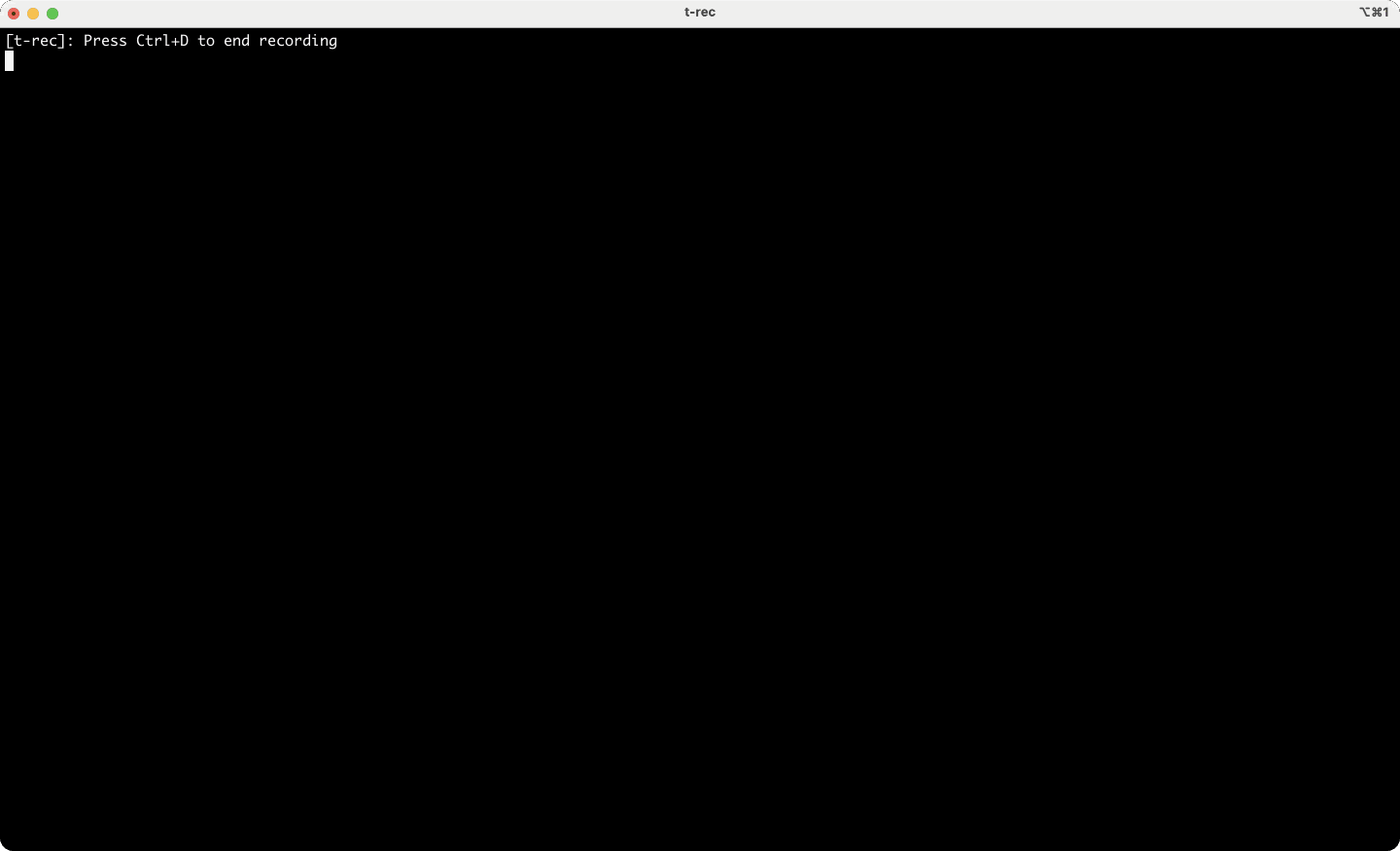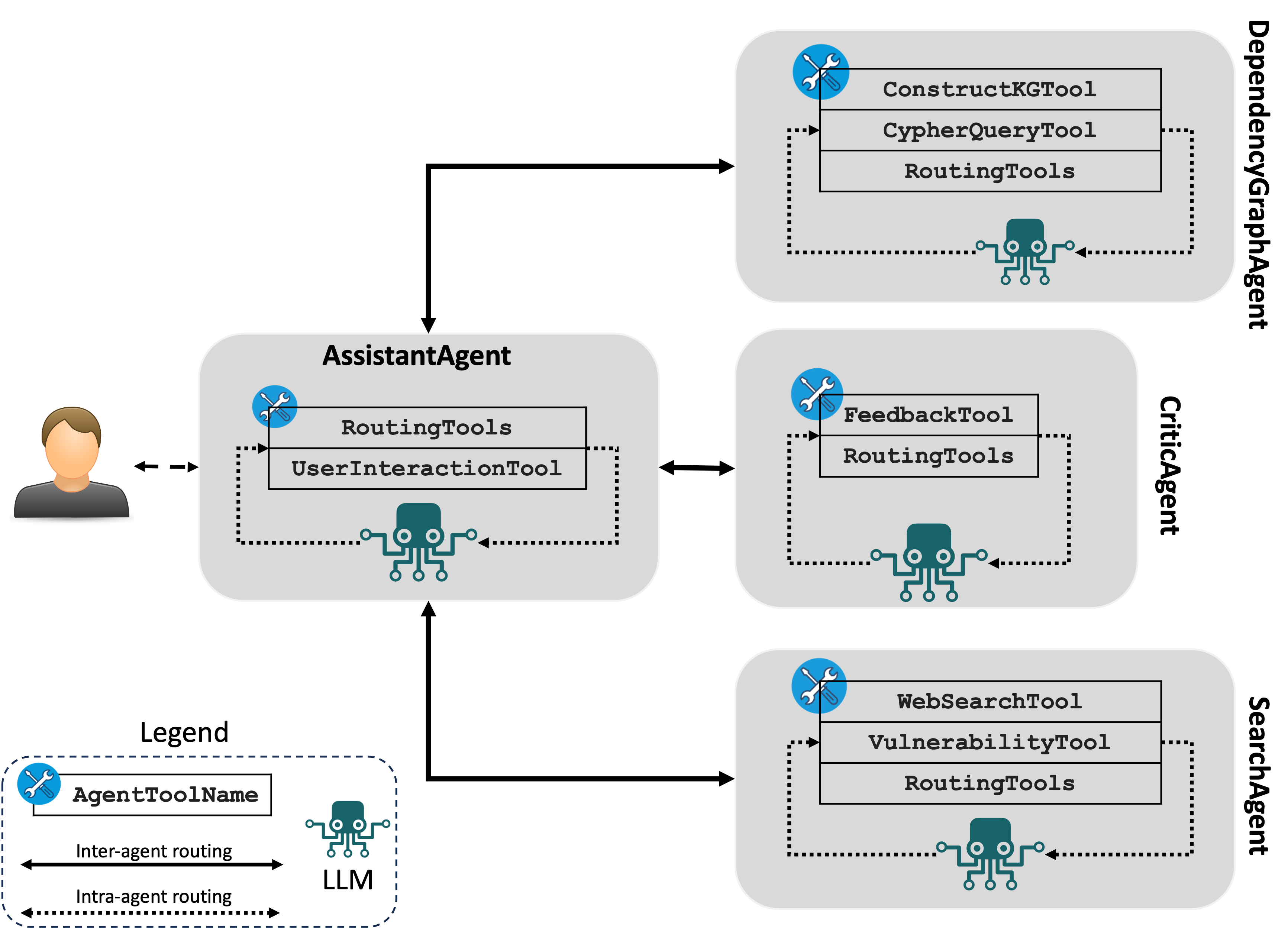DepsRAG is a chatbot that answers users' questions about software dependencies after representing them as a Knowledge Graph (KG). DepsRAG offers the following features:
- Constructing the software dependencies (direct and transitive) as a KG.
- Supporting 4 popular software ecosystems (i.e. PyPI, NPM, Cargo, and Go).
- Generating automatically Cypher queries to retrieve information from the KG.
- Augmenting users' questions with the retrieved information from the KG, as well as from the Web and Vulnerability DB.
- Leveraging critic-agent interaction to improve the reasoning and clarity of the answers.
DepsRAG comprises the following agents to accomplish its process:
- AssistantAgent. This agent orchestrates the work between the agents. It also breaks down complex questions into simple steps and then aggregates all responses to answer the user's query. This agent utilizes the following tool:
UserInteractionTool: manages the interaction between the chatbot and user.
- DependencyGraphAgent. This agent handles the interactions the with graph database that represents the dependencies.
ConstructKGTool: builds the dependency graph for a given pkg version, using the API at DepsDev.GraphSchemaTool: gets schema of Neo4j knowledge-graph.CypherQueryTool: generates Cypher queries to get information from Neo4j knowledge-graph (Cypher is the query language for Neo4j).VisualizeGraph: visualizes the entire dependency graph.
- CriticAgent. This agent provides feedback upon the final answer provided by the AssistantAgent.
FeedbackTool: provides the feedback message.
- SearchAgent.
WebSearchTool: to find package version and type information. It also can answer other questions from the web about other aspects after obtaining the intended information from the dependency graph For example:- does the dependency use the latest version for this package version?
- can I upgrade this package in the dependency graph?
VulnerabilityTool: searches OSV vulnerability DB based on the package name, version, and ecosystem.
The workflow of DepsRAG as follows:
- The AssistantAgent asks you to provide the package name, version, and ecosystem of the intended software package.
- The AssistantAgent forwards these details to the DependencyGraphAgent for constructing the dependencies (direct and transitive) as a knowledge graph.
- The AssistantAgent asks you to ask questions about the dependencies.
- The AssistantAgent decomposes complex questions into simple steps and then leverages the RAG mechanism to retrieve additional information from the Web, knowledge graph, and/or vulnerability database to augment the user's question with the additional information. This information is retrieved from the agents DependencyGraphAgent and SearchAgent.
- The AssistantAgent collects all answers and sends a final answer to the CriticAgent, which will provide feedback upon the final answer and/or provide a suggestion to refine the final answer, in case it wasn't satisfied.
For package X, version, Y, in ecosystem Z, following are examples of questions:
- what's the depth of the graph?
- what are the direct dependencies?
- any dependency on pytorch? which version?
- Is this package pytorch vunlnerable?
- tell me 3 interesting things about this package or dependency graph
- what's the path between package-1 and package-2? (provide names of package-1 and -2)
- Tell me the names of all packages in the dependency graph that use pytorch.
The following illustration shows the steps that DepsRAG will take to answer this question:
For Chainlit, PyPI, version 1.1.200, which packages have the most dependencies relying on them (i.e., which nodes have the highest in-degree in the graph), and what is the risk associated with a vulnerability in those packages?
Click to expand
-
Oct 2024:
- Adding critic-agent interaction.
-
Aug 2024:
- Adding DuckDuck web search tool.
-
July 2024:
- Creating containerized version of DepsRAG that support UI and CLI mode.
-
May 2024:
- Adding integration with OSV vulnerability database to search for vulnerabilities
-
April 2024:
- Supporting the construction of dependency graph for Go, Cargo, and NPM.
-
March 2024:
- Supporting Chainlit to run DepsRAG via UI
-
Feb 2024:
- Adding tool to visualize the dependency graph
DepsRAG requires Python 3.11+. We recommend using a virtual environment.
# clone the repo and cd into repo root
git clone https://github.com/Mohannadcse/DepsRAG.git
cd DepsRAG
# create a virtual env under project root, .venv directory
python3 -m venv .venv
# activate the virtual env
. .venv/bin/activate
# install dependencies from pyproject.toml:
# This installs DepsRAG
poetry install DepsRAG requires a set of environment variables to operate. In the root of the repo, copy the .env-template file to a new file .env to set the values of these environment variables.
cp .env-template .env
Following is a description of these environment variables:
-
LLM Settings: by default
DepsRAGsupport OpenAI modelgpt-4o. Therefore,DepsRAGrequiresOPENAI_API_KEY=your-key-here-without-quotes. However,DepsRAGsupports other models that are enabled byLangroidlike Azure, Open/Local LLMs, and other non-OpenAI proprietary LLMs. Therefore, you need to provide the corresponding environment settings for the required LLM. For example, Azure settings required are listed inside.env-templateand start withAZURE_. -
Neo4j: The easiest way to get access to neo4j is by creating a cloud account at Neo4j Aura. OR you can use Neo4j Docker image using this command:
docker run --rm \
--name neo4j \
-p 7474:7474 -p 7687:7687 \
-e NEO4J_AUTH=neo4j/password \
neo4j:latestUpon creating the cloud account successfully, neo4j will create a text file contains account settings. Please provide the following Neo4j environment variables:
NEO4J_USERNAME=typically neo4j
NEO4J_PASSWORD=your-neo4j-password
NEO4J_URI=uri-to-access-neo4j-dayabase OR bolt://neo4j:7687 if you use Neo4j Docker image
NEO4J_DATABASE=typically neo4j
We provide a containerized version of DepsRAG, where you can run DepsRAG using
Chainlit in UI mode or CLI mode.
All you need to do is set up environment variables in the .env
(as shown in .env-template) file after clonning DepsRAG repository.
We created ths script run_depsrag_docker.sh. So everything
will be working in an automated manner. Once you run this script, it will ask you to
select the mode for running DepsRAG. Then you can interact with DepsRAG chatbot.
git clone https://github.com/Mohannadcse/DepsRAG.
cd DepsRAG
docker compose build
chmod +x run_depsrag_docker.sh
./run_depsrag_docker.shThe script run_depsrag_docker.sh spins up two containers: Neo4j and DepsRAG app.
After finishing the interaction with DepsRAG chatbot, you can run the command
docker compose down to shut down the containers.
DepsRAG supports two modes: CLI and UI (using chainlit).
Run DepsRAG in the CLI mode using this command:
python3 dependencyrag/depsrag_multiagent.py
-m <LLM-Name>
The flag -m provides the option to overwrite the default LLM (gpt-4o) used by DepsRAG. If you want to use Azure, set the flag -m azure, while for other LLMs, please check Langroid documentation (Open/Local LLMs and other non-OpenAI proprietary LLMs).
Here is a recording shows the CLI mode in action:

Run DepsRAG in the UI mode using this command:
chainlit run dependencyrag/chainlit/chainlit_dependency_chatbot.py
NOTE: the dependency graph is constructed based on DepsDev API. Therefore, the Chatbot will not be able to construct the dependency graph if this API doesn't provide dependency metadata infromation.
You can find the paper that describes the details of DepsRAG HERE
@inproceedings{depsrag,
title={DepsRAG: Towards Agentic Reasoning and Planning for Software Dependency Management},
author={Mohannad Alhanahnah and Yazan Boshmaf},
booktitle={NeurIPS'24 Workshop on Open-World Agents},
year={2024}
}

